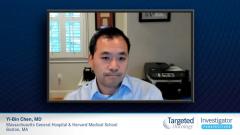
Management of Steroid-Refractory Acute GVHD
Yi-Bin Chen, MD, discusses several approaches to the treatment of steroid-refractory acute GVHD, along with the immunologic pathways they target.
Yi-Bin Chen, MD: For acute graft versus host disease, those who are refractory to first-line steroids, we did not have a standard of care until recently for steroid refractory disease. Historical therapies often focused on what we believe to be the path of physiology, which was T-cell attack of the host tissues by the donor. The traditional therapies were anti-T-cell therapies that, unfortunately, gave much more cumulative immunosuppression to these patients. And oftentimes what we dealt with was a lot of opportunistic infection and toxicity with very few patients surviving in the long run. Modern therapies have focused more on specific pathways of inflammation that we believe are active in graft versus host disease. Some trials are focused on organ resiliency, sort of preservation of organ-specific stem cells, as well as even looking at the vascular endothelium and trying to prevent what we call thrombotic microangiopathy (TMA) to improve response rates. But these days, the options we have for patients with steroid-refractory acute graft versus host disease (aGVHD) are ruxolitinib, which was approved in 2019 for steroid-refractory acute graft versus host disease, the first agent to ever be approved in this space. Some centers still do use ATG [anti-thymocyte globulin] products or anti-thymocyte globulin products in low doses. There is some literature to use TNF [tumor necrosis factor] antagonists. We ourselves have used a lot of vedolizumab, which is a monoclonal antibody against alpha(4)beta(7) integrin to modulate lymphocyte trafficking away from the intestinal tract. And there's been some recent research on microbiome-directed interventions, such as third-party fecal microbiota transplantation, with multiple anecdotes showing that success in steroid-refractory acute graft versus host disease. The mechanisms of action here are all quite varied. Ruxolitinib targets the JAK1 (Janus family kinase 1) and JAK2 (Janus family kinase 2) kinases, which are in fact active in many signaling cascades. They are active in the IO1 and IO6 signaling cascade, and they appear to also influence lymphocyte trafficking as well as preservation of regulatory T-cells. I mentioned the mechanism of action (MOA) of vedolizumab for microbiota transplantation; that all gets back to increasing the diversity of the microbiome and the interactions between the microbiome and your mucosal immune system that shape the immune system at large. ATG [anti-thymocyte globulin] is quite simply you bluntly removing donor T-cells in hopes that that can bring about the right action. And TNF blockade is self-explanatory—blocking the TNF signaling cascade.
This transcript has been edited for clarity.










































